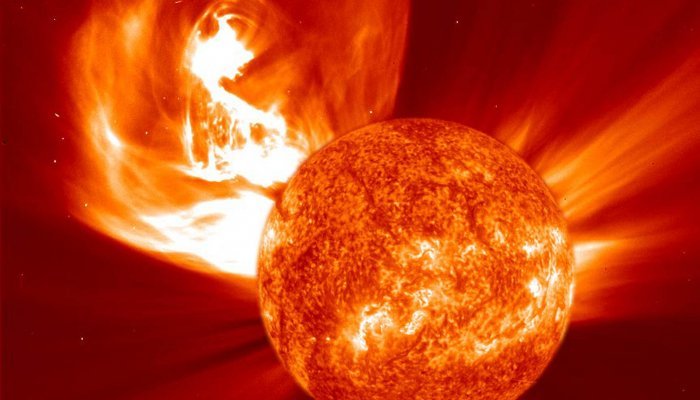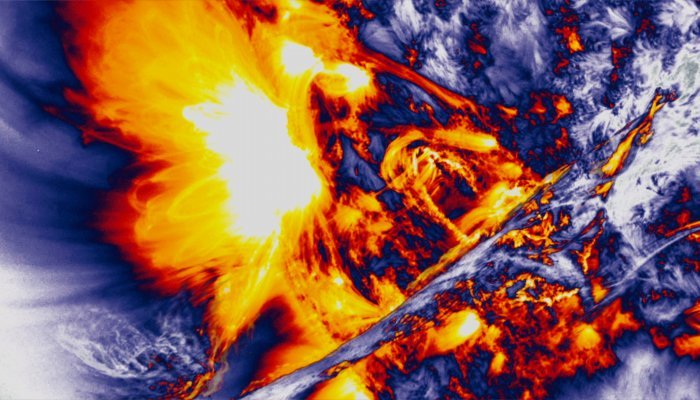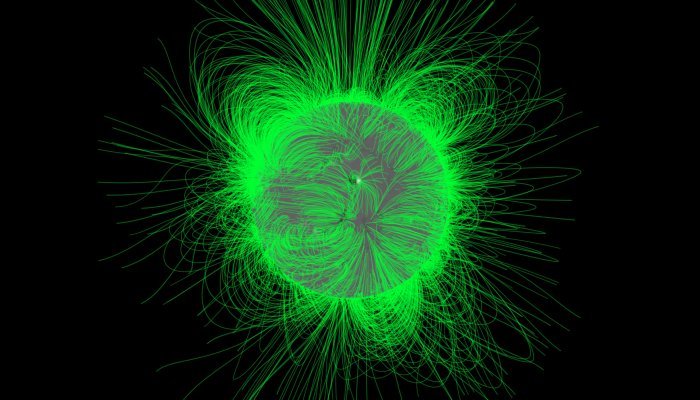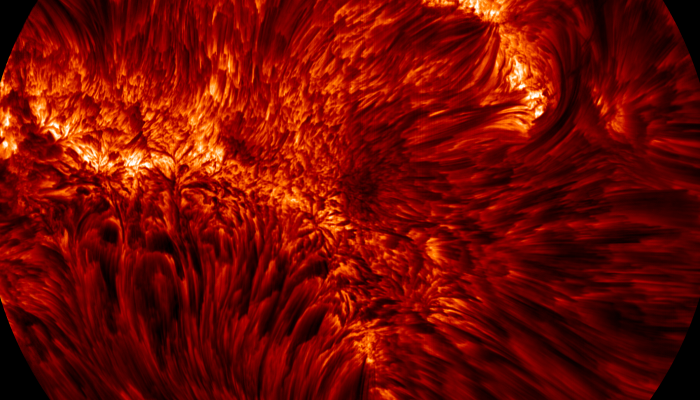
Super-storms on the surface of the Sun are more than just magnificent quirks of astrophysics. They can occur at any time, with little warning, and if sufficiently strong could wholly cripple our electrical infrastructure.
One September day in 1859, over the course of a few minutes, an event occurred that was to have spectacular consequences here on Earth. A sudden, vast, and tumultuous eruption of solar flares and coronal mass ejections (CMEs) had just been released from the surface of the Sun, blasting swathes of X-rays and about a trillion kilograms of charged particles at speeds of some 3,000km/s towards the Earth. This event, in terms of energy, was equivalent to 10 billion Hiroshima bombs exploding simultaneously. There really is no way of comprehensibly expressing just how immense of an event it was.
The collision between those charged solar particles and the Earth’s magnetosphere - the magnetic shield that usually protects us from high energy particles - swiftly stretched and tore it apart, triggering the largest ever “solar super-storm” in recorded history. The Northern and Southern Lights were swept from the poles to the Equator. The surge in energy crippled the world's electrical infrastructure.
Back in the mid-19th century, thankfully that infrastructure amounted to no more than about 200,000 km of telegraph lines. The impact to humanity was relatively benign. But in today’s world, which is ever more dependant on space technology and massively interconnected networks of power lines and fibre-optic cables, if a Carrington-type event (Named after the English astronomer Richard Carrington, that witnessed the event of 1859) were to repeat itself, the consequences would be catastrophic and long-lasting.
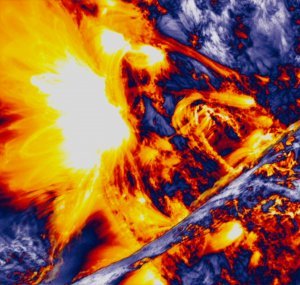
Our electrical infrastructure, that now shrouds the surface of the Earth, and the magnetosphere that encompasses and bathes it are intimately tied together. So fundamental is this tie, that the study of electricity and magnetism has in the past century become lumped into one area of science: electromagnetism. Any change to the Earth's magnetic field generates a natural electrical charge. Any device tapping into the electromagnetic spectrum is therefore affected by geomagnetically induced currents (GICs). On small-scale electronic devices like mobile phones, these charge build-ups are negligible. However, when it comes to large-scale electrical systems, like power transmission-lines, the story changes.
It has now dawned on us – thanks to data from NASA’s Kepler mission (see box 1), numerical modelling and the study of historical records – that the mood of our nearest star is far more hostile than we used to think. Carrington-level events occur every couple of decades – though we are only ever in the path of around a tenth of them. According to Jim Green, director of NASA’s planetary-science division, “the Earth is, on average, in the path of Carrington-level events every 150 years”.
Moreover, according to estimates made by Peter Riley, a heliophysicist at NASA and the US Department of Defense, the probability of another Carrington-level event occurring within the next decade is as high as 12%. In fact, in July 2012, a Carrington-level event occurred. Thankfully it erupted on the opposite side of our star.
Some of you may remember the “Halloween storm” in October 2003. It was about 15% the intensity of a Carrington-level event, yet it disabled a number of satellites and destroyed 14 large 400kV-class electrical transformers across South Africa, crippling large sections of the country's power infrastructure.
Since then, very little has been done in the effort to mitigate against future potential threats to the South African electrical infrastructure. A decade after the 2003 Halloween storm, Professor Charles Trevor Gaunt of the University of Cape Town is still pleading at the proposal level for the government to begin implementing such mitigation strategies, “the risk of an extreme storm cannot be ignored”.
As Pete Worden simply put it to me, “space weather destroys stuff”. As a professor of heliophysics, a 2-star air-force general, and the then the director of the largest centre for space research and activities, NASA Ames Research Centre, he more than anyone is an authority on this subject.
But how much damage are we actually talking about? How would the sequence of events play out if a Carrington-level event occurred tomorrow? And what strategies can we adopt to mitigate damage?
The SolarMAX Task-Force
To help find answers, I was invited by the UK and European Space Agency to take part in a 40-strong international, multidisciplinary task force of experts, led by Pete Worden and Jim Green. Over a period of six weeks, our group – dubbed SolarMAX – gathered to work out the risks from a solar super-storm to our modern way of life and to identify the best ways of limiting the potential damage. The result was a 100-page document for dissemination to governments, space agencies and industry. You can read the full report online (http://ow.ly/yDOXp).
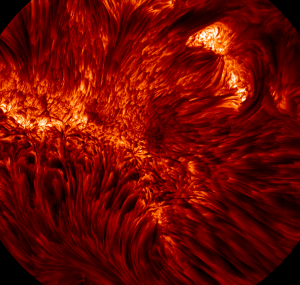
It would be nice to pretend that things would be okay in the event of a solar super-storm striking the Earth, but our findings were deeply sobering.
Carrington-level disturbances to the Earth's magnetic field would induce currents large enough to cause widespread damage to overhead transmission lines, and in particular to transformers regulating the power-grid. New transformers typically require a year lead-time for manufacture before installation, and at R135 million a pop, utility companies rarely keep large reserves of such systems.
Concurrent destruction of a large number of transformers across the US and UK would cause widespread power outages that would likely last several months or more. Interestingly, China and India would be significantly less vulnerable to such an event. Not only because of their more equatorial latitudes, but because of generally less GIC conducive soil and relatively modern power infrastructures. I dare say that it is well within the realm of possible that a Carrington-level event could massively change the geopolitical map of today.
What such an event would do to the South African electrical infrastructure, especially given its degraded and ageing status, is something I would rather not put into words. The demand for replacement transformers to bring the infrastructure back online would wildly outstrip the supply capacity. Rapidly increasing that capacity through well-coordinated government declared emergencies and resource redistribution would not be a simple feat.
Without power, people would struggle to fuel their cars at petrol stations, get money from cash dispensers or pay online. Water and sewage systems would be affected too, meaning that health epidemics in urbanized areas would quickly take a grip, with diseases we thought we had left behind centuries ago soon returning.
Worse still, most of the developed world works on a “just-in-time” philosophy, meaning that there is never more than a few days worth of supplies available in urban areas at any given moment, be it food, fuel or medicine.
Pilots, typically fly above about 80% of our atmosphere are exposing them to an order of magnitude more radiation than people on the ground. Already classified as radiation workers, a Carrington-level dosage would significantly reduce a pilots service life and would potentially threaten their long-term health to some extent. Significant interruptions to primary navigation management and communications systems would occur.
Satellites would be affected too, with the electrostatic discharges generated by geomagnetic storms frying electronics, damaging solar panels and confusing star-tracking orientation systems. The Earth’s atmosphere would also heat up and expand during such an event, increasing the drag on satellites in low Earth orbit, significantly reducing their expected lifetime. Many TV broadcasts would cease. Radios and mobile phones would have limited functionality, suffering from similar infrastructure problems to those in the power sector. Weather forecasts services would be limited. A swathe of recently developed defence and deterrent systems would be compromised.
A significant proportion of the satellites that run navigation systems would either be lost entirely or produce data of limited use – hitting agriculture, surveying, oil drilling and timing. Our transportation-management infrastructure would grind to a halt, from air to sea. With more than 1,000 operational satellites in orbit (costing an average of about R1 billion each), our space infrastructure could take a decade or more to recover. In fact, a study carried out in 2008 by the US National Research Council estimated that the satellite blackouts caused by space weather could cost the global economy upwards of R27 trillion in the first year alone.
Meanwhile a separate 2013 study by insurance broker Lloyd’s of London and Atmospheric and Environmental Research, a climate and weather risk-management agency, estimated that the total collateral damage of a Carrington-level event on the global economy would amount to some R35 trillion.

South Africa's Energy Plans
Nuclear power plants are another major concern as they rarely have more than a week’s worth of backup power on-site to run their cooling systems. A switched off reactor usually takes a month to cool down far enough to avoid a meltdown, which means that firms would find themselves fighting to get their hands on supplies of diesel fuel to operate those backup systems. With more than 400 nuclear reactors across the globe, how many catastrophic meltdowns could be circumvented?
The South African government has given Eskom the go-ahead to build six new nuclear power plants over the coming decade, with increased capacity of 9,600 MW expected by 2030. It is expected that this endeavour will cost between R105,000 – 140,000 per kW.
Last year, Eskom shut down two power plants due to diesel shortages, and an additional two due to depletion of water reserves. If South Africa's main power supplier is unable to maintain systems continuously during the normal ebb and flow of resources, how can it be expected to prevent six additional nuclear power plants from catastrophic meltdown during the long-term global power and resource crisis a Carrington-level event could catalyse? The International Atomic Energy Agency has found that South Africa's nuclear preparedness is deficient in more than 40% of its assessment criteria.
The South African Government spent approximately R41 billion to host the 64 soccer matches that were the 2010 FIFA World Cup. The government estimated it would make approximately 30% of this back primarily through the tourism generated – the reality was about 17%; ending in a loss of R34 billion. Tourism in South Africa since the event has been little affected, and how much of that can be attributed as a direct consequence of profile raising from the event 5 years ago, and how much can be attributed to a global economy recovering from the hangover a financial crisis remains an open question.
One of the largest solar power farms in existence, the California-based Topaz Solar Farm, began construction in 2011 and became fully operational last year. The low-complexity system is now produces about 550MW of clean energy. It is expected to do so for between two and three decades before significant maintenance actions need to be taken. Topaz cost approximately R34 billion – which is coincidentally exactly as much as South Africa lost in profits after spending R41 billion to host the 64 soccer matches that were the 2010 FIFA World Cup.
Given the difference in latitudes and consequential levels of sunlight, a Topaz-scale farm just north of Johannesburg would register in the 700MW-class. Using the photovoltaic technology of 2011, that translates into a rate of approximately R50,000 per kW brought online within a few years. Based on figures over the last few decades, however, the cost of solar power per kW is halving every 5 years – so the 2011 rates are already significantly out of date.
South Africa's GDP has dropped by 13% in the last 5 years. The nation's neglected electrical infrastructure is classed as “junk” and in dire need of major overhauls. Why the South African government is pursuing nuclear power over solar power is beyond me. Nuclear power plants are vastly more complex systems requiring great levels of intricate maintenance. They evidently require about three times as much investment capital and a decade more lead-time. And unlike solar power, during natural disasters like solar super storms, they become a critical danger to the population they serve through the threat of meltdown.
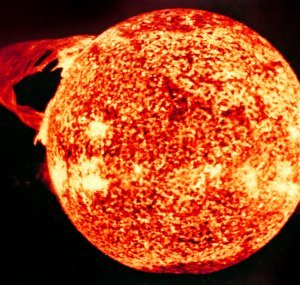
Mitigation Strategies
You may feel that I am scare-mongering, but the plain fact is that our reliance on electricity has made us extremely vulnerable to anything that could cut supplies.
To protect our electrical infrastructures, there are two main facets that need to be addressed: forecasting and optimisation.
Right now, we cannot reliably forecast a CME or solar flare eruption on the surface of the Sun by more than about an hour. On top of this, we cannot reliably predict the paths emitted charge particles are going to take between the Sun and the Earth's orbit during such solar storms. We have a few satellites orbiting the Earth acting as outposts that give approximately 30 minutes warning of an imminent impact. Garnering a deeper understanding of the Sun's weather and the relationship between the Sun's and the Earth's magnetic fields would likely better these forecasts. An effective method for deepening knowledge and giving earlier warnings would be with a constellation of micro-satellites in an orbit slightly closer to the Sun. SolarMAX estimated such project would cost NASA in the region of R7 billion.
A way of minimizing the potential disruption from space weather is to exploit the fact that many nations are slowly updating their power transmission lines so that energy use can be measured at different points in the grid in real time via “smart meters”. This technology lets energy companies monitor and adjust performance to deliver power more efficiently in response to local changes in demand. Such information would be invaluable during major solar events. A real-time solar-weather response system integrated into the power management system would help to reduce the damage to the power grid by isolating vulnerable segments of the network from the rest of it to allow for smaller local failures rather than large inter-connected failures.
The risks are real. Solar super-storms are not a question of “if”, but “when”. However, damage can be averted with the technology we have today. The primary obstacle and danger lies not within the Sun itself, but with the ignorance of decision-makers concerning space weather: governments, industry and the public. As a species, we have never been more vulnerable to the volatile mood of our nearest star, but it is well within our ability, skill and expertise to protect ourselves.
NASA Kepler Space Observatory
To get a clearer idea of how often Carrington-level events are likely to occur, researchers at NASA are currently mining data from the Kepler space observatory. The mission was designed primarily to discover Earth-like planets orbiting other stars and has so far gathered data on more than 170,000 “main-sequence” stars in our galaxy. But by observing the variation in the luminosity of these stars over time, astronomers can spot and quantify the scale and likelihood of stellar super-storms.
Although only a small fraction of the Kepler data has been scoured for super-storms, the work has shown that the solar flares in the Carrington event of 1859 really were nothing special for a star like the Sun. Preliminary estimates reveal that super-flares with energy levels a thousand times greater than a Carrington-level event occur every few thousand years.
Studying the Kepler data has also given insights into how the properties of a star affect its volatility. For example, its rotation rate does not seem to alter the scale of super-flares produced, but the higher the rate, the more likely a super-flare event is to occur. The good news – if you can call it that – is that our star has a relatively low rotation rate.


